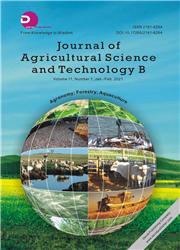Performance of Medicinal and Aromatic Chamomile (Matricaria chamomilla L.) under Different Planting, Manure cum Fertilizer Regimes in Kathmandu Valley
引用次数: 0
Abstract
New and old genotypes of German chamomile (Matricaria chamomilla Linn.) were experimented under different planting methods, manure and fertilizer combinations first time in Kathmandu valley. The researches aimed at evaluating genotypes performance, identifying suitable planting method and optimum combination of manures and fertilizers. The germplasm evaluation experiment was conducted at the National Agriculture Research Institute (NARI) field, Khumaltar during January-May. Planting method trial was laid out in randomized complete block and manure cum fertilizer trial was in Latin square design (LSD). The results showed good performance of chamomile growth, development and oil content. Major agronomic traits had average figures in all experiments comparable to chamomile growing areas. Most data differed significantly and at par. New genotype produced relatively higher number of branches, leaves and flower heads maintaining more plant density. Growth was higher in row sown and transplanted plots, row sowing found more beneficial. Transplanted plots delayed maturity. Transplanted (0.95%) and broadcasted (0.80%) chamomile gave higher oil percentage, no difference found between genotypes. Significantly (p < 0.05) higher and at par branch numbers, flower heads, biomass yield, plant height were recorded in the treatments with higher rate of farm yard manure (FYM) 20 t/ha followed by combined application of NPK 60:40:20 kg/ha plus manure 10 t/ha. Oil content was the highest (0.95%) in FYM (20 t/ha) applied plots followed by combined fertilization (0.80%). Despite inferior to treatment N:P:K 60:40:20 kg/ha only to enhance growth and oil production, other results suggested suitable technology and successful cultivation of chamomile in valley conditions are recommended.药用和芳香洋甘菊在加德满都谷地不同种植、施肥制度下的表现
首次在加德满都谷地对德国洋甘菊(Matricaria chamomilla Linn.)新旧基因型进行了不同种植方式、肥料和肥料组合的试验。研究的目的是评价基因型性能,确定适宜的种植方法和最佳的肥料和肥料组合。种质评价试验于1 - 5月在印度国家农业研究所(NARI)库姆塔尔大田进行。种植方法试验采用随机完全区组设计,粪便和肥料试验采用拉丁方设计(LSD)。结果表明,洋甘菊的生长发育和含油量表现良好。在所有试验中,主要农艺性状的平均值与洋甘菊种植区相当。大多数数据差异显著且基本相同。新基因型产生相对较多的枝、叶和花头,保持较高的植株密度。行播和移栽小区生长较高,行播更有利。移栽地块延迟成熟。移植洋甘菊(0.95%)和播散洋甘菊(0.80%)产油率较高,基因型间无差异。施用有机肥20 t/ha、氮磷钾60:40:20 kg/ha配施有机肥10 t/ha处理的枝条数、花首数、生物量产量和株高均显著(p < 0.05)高于对照。含油量最高的是化肥(20 t/ hm2),其次是联合施肥(0.80%)。虽然氮:磷:钾60:40:20 kg/ hm2的处理仅能促进生长和产量,但其他结果表明,建议在山谷条件下采用适宜的技术和成功的栽培洋甘菊。
本文章由计算机程序翻译,如有差异,请以英文原文为准。
求助全文
约1分钟内获得全文
求助全文

 求助内容:
求助内容: 应助结果提醒方式:
应助结果提醒方式:


